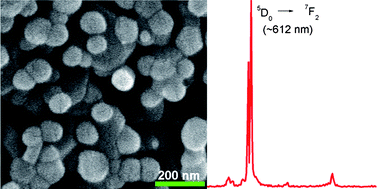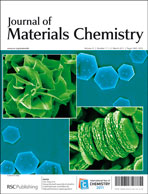An attempt has been made to synthesize sulfur free Eu3+-activated M1−xMoO4:Eux3+ (M = Zn, Mg, Ca, Ni and Co; x = 0.2) phosphors by an oxalate sol–gel process. The process involves gel formation from solutions of metal nitrates in ethanol, ammonium heptamolybdate tetrahydrate in de-ionized water and oxalic acid in ethanol, digestion for 12 h, drying at 100 °C for 24 h, decomposition in air at 600 °C or above to yield fine grained powder exhibiting different morphologies, viz. distorted spherical agglomerates, dumbbell shaped particles, rectangular bars, faceted particles, ellipsoids or parallelepipeds. The optical absorption bands have been attributed to (i) ligand-to-metal charge transfer (LMCT), i.e., oxygen to molybdenum in the MoO42−group and (ii) f–f electron transitions (viz., 7F0 → 5L6 at 395 nm and 7F0 → 5D2 at 465 nm) of Eu3+ ions upon excitation with a wavelength of ∼395 nm, which occupy non-centrosymmetric metal (M) sites. Eu3+ ions exhibit a strong electric dipole 5D0 → 7F2 transition emitting red light at ∼612 nm with quantum efficiency in a 1.0 : 1.7 : 3.2 ratio for M0.8MoO4:Eu0.23+ (M = Mg, Zn and Ca) phosphors, respectively. Further, their CIE coordinates are (x = 0.68 and y = 0.32) close to known values (x = 0.665 and y = 0.331) of Y2O2S:Eu0.053+ red phosphor. Hence, M0.8MoO4:Eu0.23+ (M = Mg, Zn and Ca) phosphor can possibly be a potential alternative to Y2O2S:Eu0.053+ for fabrication of near UV InGaN based light emitting diodes. Yet, another phosphor of composition Co0.8MoO4:Eu0.23+ is shown to have promise for white light emission with its CIE coordinates as x = 0.279 and y = 0.245.


 Please wait while we load your content...
Please wait while we load your content...